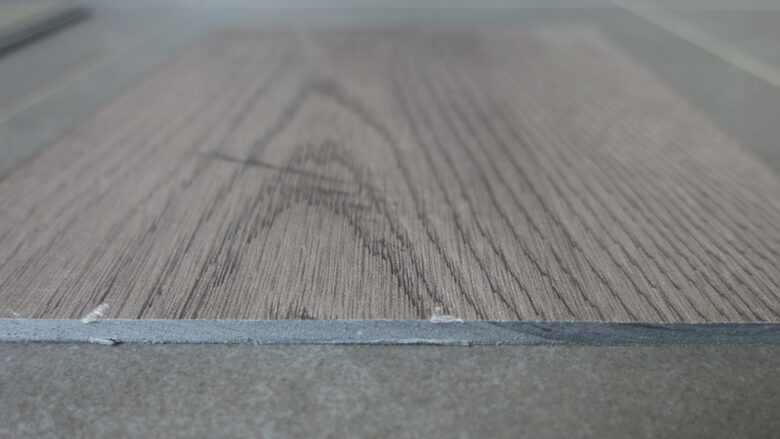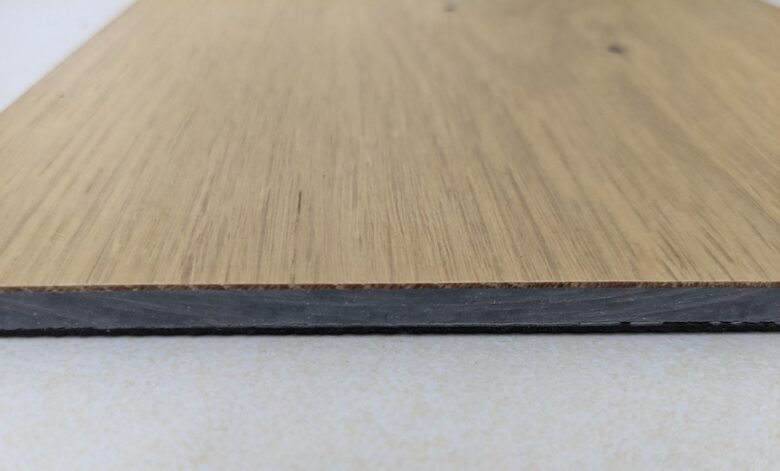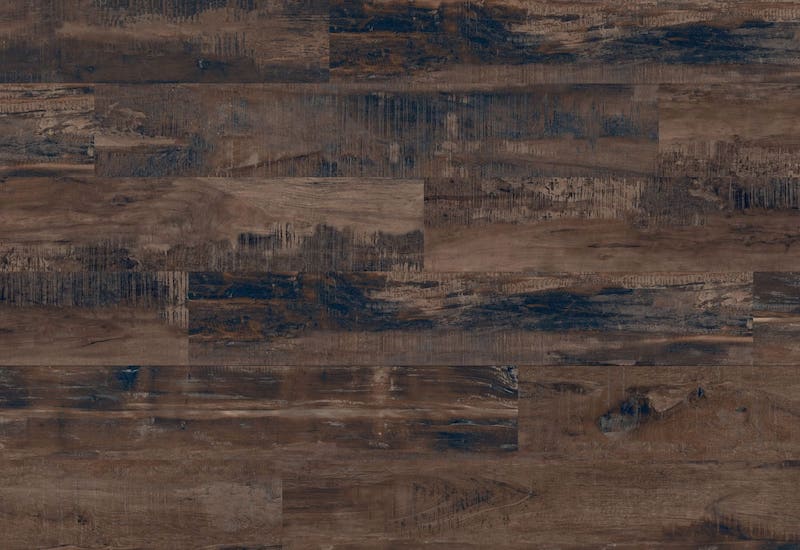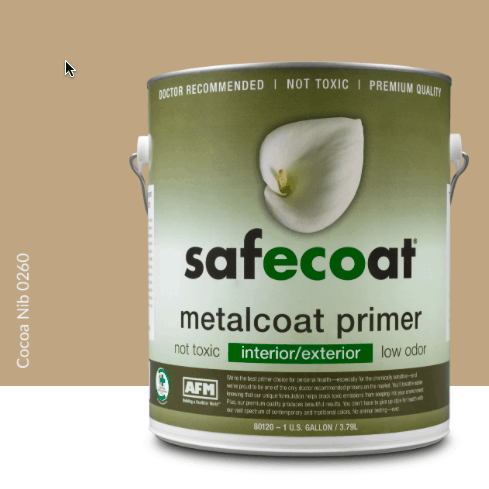Usually, vinyl sheet flooring is used in trailers and RVs. Vinyl sheeting has significant offgassing. The post outlines healthier options.
Metal and fiberglass homes have unique challenges with thermal bridging and humidity and often require waterproof flooring that can hold up to some moisture.
The following list is the flooring I would specify in vans, metal trailers, fiberglass trailers, and any other tiny house made of metal (like SIPS), plastic, or fiberglass.
This type of flooring is often used in commercial buildings and schools and can of course be used in residential kitchens and bathrooms.
This post contains affiliate links. Upon purchase, I earn a small commission at no extra cost to you.

1. Odorless Sheet Flooring (Non-Vinyl)

Kahrs Xpression and Zero Tile are two odorless plastic-based sheet floorings. These are an excellent alternative to vinyl sheet/rolls.
These Kahrs floors are made from minerals and the plastics TPE and polyolefin. Polyolefin in this case almost certainly means PE (polyethylene) and/or PP (polypropylene). They don’t use any plasticizer and there is no PVC.
I was impressed and I was happy to see a healthy alternative to PVC sheet flooring. I even found these much lower in offgassing than luxury vinyl plank (LVP).
These do require a glue though. You would have to test that when comparing this to other options. LVP comes in a click down which eliminates the need for glue.
In all trailers that I have seen, glue -down flooring is used, and it’s almost always vinyl sheet.
2. Bio-Based Polyurethane

Bio-based polyurethane means it’s made of 90% natural oils like castor oil (no linseed). It barely has an odor. It also contains minerals. The backing gives off just slightly more odor than the top – the backing contains PE and fiberglass.
Shaw Contract (which is a commercial line) has a bio-based polyurethane. While this brand is not available to individual homeowners, it’s a product we can push for in mass-produced trailers, schools, offices, and other places where vinyl sheet might normally be used.
Another company making bio-based polyurethane for homeowners (non-commercial) is Wineo, their Purline Organic Flooring. They have dealers in Europe, Asia, the US and Canada. Their flooring is pictured above.
I really like these polyurethane floors, and these are my top pick for healthy resilient flooring. They seem to have almost no offgassing and do not contain other persistent chemicals like plasticizers.
In terms of what’s in them, Mannington Mills (commercial) provides a full Declare label on their acrylic-polyurethane sheet flooring here, (they also claim to be 0 VOC) and Tecknoflor provides their full Declare label on their polyurethane floors here.
3. Non-PVC Click-Together

Mohawk also has a new waterproof click-together flooring called PureTech. It’s made of minerals (including corundum) and plant fibers, it’s completely free of PVC and plastic (except for the underlayment which is a foam). It’s also free of formaldehyde and plasticizers. It’s not clear what the binder is.
Sono Eclipse is a PVC-free rigid core flooring made in Germany. It is made without phthalates or other plasticizers. That is huge, as plasticizers are the biggest chemical of concern in LVP floors. They also claim it’s made without chlorine or other additives. The core is made of polypropylene (PP) and mineral powder. Like LVP, it is waterproof and non-organic. I’ve seen a sample and it looks like feels almost exactly like LVP.
Another company Hallmark Floors, makes a rigid glue-down plank made of polypropylene. I could not pick up any offgassing, and like other PP floors, it does not have any added plasticizer or chlorine and it does not contain recycled content.
4. Odorless Mineral-Based Vinyl

UPO Quartz Tile is a stiffer tile than the Xpression and Zero Tile. It’s made of quartz mineral and PVC. With no phthalates and no DHEP.
I tested this product before I knew it was PVC and was quite surprised when I found out what it was made of. Going based on offgassing, this is my top choice alongside the Xpression and Zero tile.
I have never tested another vinyl product with such minimal offgassing.
I did not like this company’s Safety Floor, which is a flexible vinyl that had too high offgassing for me.
This video compares Quartz Tile, Xpression, Zero Tile and Shaw Contract Bio-Based polyurethane:
5. Natural Linoleum

Marmoleum can be used in some metal or fiberglass spaces.
The Marmoleum sheet has jute on the back. The tiles have a polyester backing, which makes it more suitable for a trailer. Marmoleum click is not that different from a laminate floor with a wood (HDF) substrate. I wouldn’t use that in a trailer.
With Marmoleum, I would make sure you have plenty of insulation underneath and an underlayment with a thermal break to prevent condensation.
Marmoleum is made from linseed oil, pine resin, wood flour, limestone, and dry pigments which are mixed and then calendared onto a natural jute backing. It’s got a UV-cured sealer on top.
Not everyone tolerates the glue used to install it but they do claim it’s 0 VOC. It’s an acrylic adhesive, which is good. It does contain biocides. I do not know of any alternative that can be used with this product.
I found that after one month the odor all but disappeared from the product – though many people say the odor never disappears 100%, but rather it comes out when heated.
6. Luxury Vinyl Plank or Tile (LVP, LVT)

Luxury vinyl plank (LVP) is much more tolerable than people generally think. Though it’s not as good as the options above.
It is very low VOC, and most of it is phthalate-free now. A benefit over other options here is that much of LVP is click-together and doesn’t require adhesive.
My top brand is Cali Bamboo it’s very low in offgassing.
More details on what’s in vinyl plank and my top brands in my post on LVP.
Double-check on all brands to make sure it’s virgin (not recycled) vinyl. I prefer phthalate-free but other plasticizers can be problematic too. This flooring can also contain metals. I discuss that issue more here.
7. Vinyl/Wood Hybrid

A new type of flooring, Opti-Floor is a vinyl core, just like LVP with real wood on top.
I was pleasantly surprised when I bought a sample. I did not pick up any offgassing (though I’m not sure how old this sample was). It seemed to not have the plasticizer odor/offgassing of LVP.
It also did not have the strong odor of a wood substrate or even of a typical wood stain on top.
If you need a waterproof base this can go over metal or other damp areas.
The wood on top is of course not going to be able to take huge amounts of water, but you won’t have water and wood trapped together somewhere where you can’t see it.
8. Magnetic Tiles

I tested Kablan’s magnetic ceramic tiles. These are ceramic tiles with a magnetic backing. The other side of the magnet is an underlayment that is glued down to the floor. No thin-set or grout here.
I found they the magnetic backing components did have a moderately strong smell, though you may not be able to smell them at all (or very much) once the floor is installed.
I have a video review of them here.
These are much lighter than regular tiles. They have made them even lighter since I made that video. It might not work for many structures on wheels but it can work in more stationary homes including metal or fiberglass modular homes where you would want real tile.
9. Limestone & Polyester Tiles

I tested Armstrong’s Bio-Flooring, both Striations BBT and Migrations BBT. These are a rigid tile flooring that can replace vinyl, though they are glue-down.
They are made from 85% limestone, polyester, and a polymer (plastic) made from corn. I was surprised by the level of offgassing here. I was expecting it to be much lower. This is not something would be able to use in my home.
Whether it’s better than LVP I think would be very individual. I didn’t think so.
10. Simple or Unusual Floor Coverings
Metal sheets:
Metal sheets can be the final flooring in a customized trailer or metal SIPS house. They could be painted with AFM Metal Primer with different designs for a pretty effect, or covered with rugs or mats listed below.

Flooring made for Decks and Garages
These come in plastic and wood/plastic. The wood could be real solid wood or a composite, a lot like wood decking products. You would likely have to check out a sample to see if this works for you.
I like these because they allow an air gap on a floor where you couldn’t put a flooring right on the substrate. This would apply to concrete slabs that were not poured properly (like most garages and sheds) and metal floors. The downside is it would be a pain to have to lift them all the time to clean underneath.
- All plastic polypropylene click-together tiles like GarageTrac as the rigid final floor covering.
- Hard plastic with real wood on top.
Plastic Sheets, Carpets, and Mats
Other unusual options for trailers:
- Hard plastic sheets (polycarbonate or acrylic) as a structural floor layer.
- Plastic carpet (non-vinyl) as a non-slip layer.
- Rolls of flexible silicone as a cover over metal.
- Silleather (silicone leather) floor covering.
- EVA mats (this formamide-free one) as a final floor covering.
- Polyethylene with polyurethane leather playmate, a very cushiony “rug”!
- TPU mats as a floor covering or non-slip “rug”
- Non-toxic yoga mats, like TPE as a rug or floor covering.
Where you might need these flooring types?
Floors of metal vans. Metal and fiberglass trailers – both conventional and custom-made.
Metal and fiberglass tiny or modular homes, including metal SIP homes.
Some of these might apply to boats or other homes on water.
Schools and other commercial spaces that normally use resilient sheet flooring.
Wet spaces like kitchens and bathrooms.
In these living spaces organic flooring like wood, engineered wood, and laminate are not usually used. It’s preferable to have an inorganic flooring that holds up to condensation, leaks, spills, and high humidity.
Corinne Segura holds certificates in Building Biology, Healthier Materials and Sustainable Buildings, and more. She has 10 years of experience helping others create healthy homes.
Did you find this post helpful? If so you can buy me a coffee to support the research behind this blog. Thank you!

Laurel Creager
Hi! I have an avian rescue and I’m desperately looking for a way to cover my existing and depleting old hardwood floors with a sheet of something. I want the floors to be a solid white and easy to clean. So basically no cracks. I’m so stumped on an adhesive. I even thought of doing hot glue. Everything has to be zero voc and more. The smallest smells kill birds. I thought about purchasing sheets of plywood, painting them with zero voc and trying to seal them and cure them for a month to then hot glue down. Please help! I’ve asked a million people and still can’t find a great plan.
Corinne
probably the PU, but I don’t know what is good for birds
Rozalina Gutman
I’ve heard during lecture on toxicity that limestone may be toxic especially for lungs. I wonder if you have checked this aspect
Corinne
the dust from stone, wood, gypsum, concrete etc etc are harmful to breathe in. In terms of flooring with limestone, I don’t know that you could isolate any limestone dust in that process – it’s very enmeshed into the plastic. Anyway, if you somehow manage to create dust, you should always clean up particulates well after any reno/construction job.
Rozalina Gutman
I’ve heard that limestone may be toxic especially for lungs. I wonder if you have checked on this
Angie
Hi,
Where can you buy UPO Xpression and Zero Tile? I’m in Canada but can’t find any retailers listed online in Canada nor the US. Would love to buy it. It sounds like a great product.
Thank you!
Corinne
You will have to ask the company where the vendors are located.
Angie Fenwick Gibb
Will do. Thanks! 🙂
Sara
Hello,
Do you have any recommendations for non-toxic mats to put down on the floor of a minivan? We have a carpeted minivan and need something to catch the mud and dirt. I was reading about rubber floor mats for vehicles and it sounds like they gas off and smell terrible. And usually anything made of carpet would do the same. I’m wondering if I’ll have to think outside the box…. like would the Rolls of flexible silicone you mention up above work, I wonder. I’d have to cut them to the right size/length. Or some other material? Hmmm….
Thanks for any ideas.
Cas
Hello,
I’m curious why you don’t recommend laminate flooring in an RV?
Thanks!
Corinne
It’s the least durable option with water and condensation.